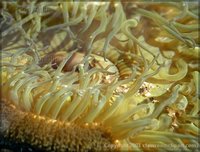Sea anemone
|
|
| Sea Anemones | ||||||||||
|---|---|---|---|---|---|---|---|---|---|---|
 Giant Green Anemone, Southern California | ||||||||||
| Scientific classification | ||||||||||
| ||||||||||
| Families | ||||||||||
|
Many, see text. |
Named after a terrestrial flower, the anemone, the sea anemone is a group of water-dwelling, filter feeding animals of the order Actinaria. As a cnidarian, it is closely related to coral and jellyfish. The anemone is a (usually) solitary polyp with stinging cells (cnidocytes) in its tentacles. These stinging cells serve to paralyze and capture prey, which is then moved by the tentacles to the mouth for digestion inside a central cavity.
Other close relations to the sea anemone are the solitary, tube-dwelling anemones and the hydras.

The sea anemone has a foot which in most species attaches itself to rocks or anchors in the sand. Some species attach to kelp and others are free-swimming. Although not plants and therefore incapable of photosynthesis themselves, many sea anemones form an important symbiosis with certain single-celled green algae species which reside in the animals' gastrodermal cells. These algae may be either zooxanthellae, zoochlorellae or both. The sea anemone benefits from the products of the algae's photosynthesis, namely oxygen and food in the form of glycerol, glucose and alanine; the algae in turn are assured a reliable exposure to sunlight, which the anemones actively maintain. The preponderance of species inhabit tropical reefs, although there are species adapted to relatively cold waters, intertidal reefs, and sand/kelp environments.
Some sea anemones form symbiotic relationships with crabs and anemone fish, also known as clownfish. In the former situation, anemones will either attach or be attached to the shell of a hermit crab (by the crab's own volition), providing additional protection for the crab and allowing the anemone to eat scraps when the crab feeds. A similar relationship can be formed between a sea anemone and a clownfish. The clownfish presses itself into the anemone, living comfortably within the stinging tentacles: This is possible because of a protective mucus that covers the clownfish. The clownfish benefits from this symbiotic relationship because it is protected by the anemone. The anemone benefits because the anemone gets food scraps from the clownfish.



